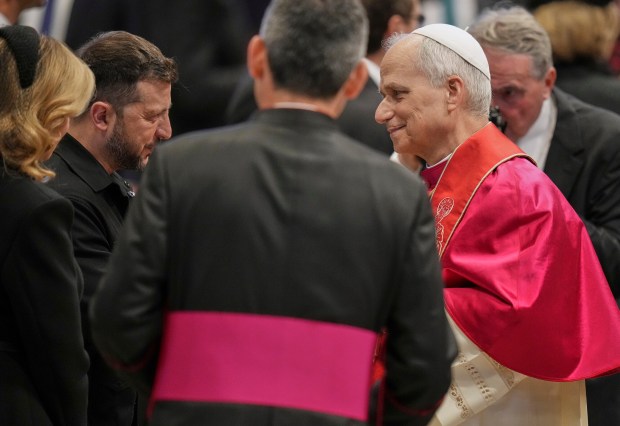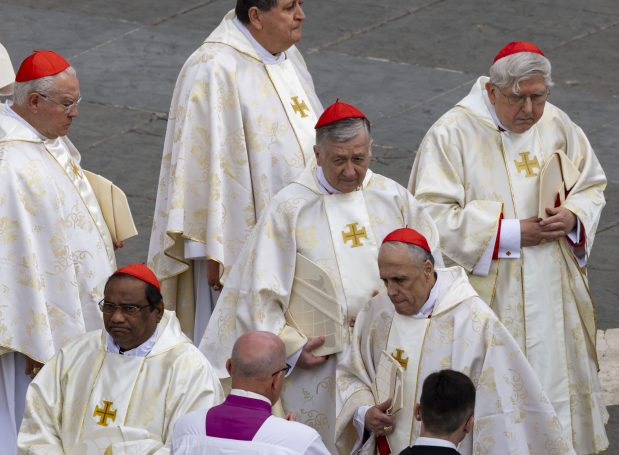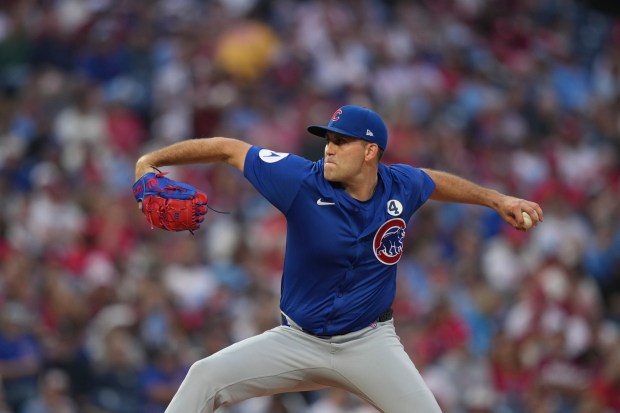ROME — Chicago Cardinal Blase Cupich says Pope Leo XIV will prioritize the environment and needs of immigrants, citing major themes throughout the pontiff’s homily during his inaugural Mass on Sunday.
The new pope, who hails from Chicago, will also work tirelessly to help end international conflicts, the cardinal said.
“He will continue speaking about how globalization marginalizes people,” Cupich said during an interview Monday with the Tribune at Pontifical North American College, his alma mater. “Especially if the metric for measuring the success of globalization is economical and financial rather than how does it help people universally flourish. We are going to hear more about that, I’m positive.”
But the archbishop of Chicago doesn’t know when the Holy Father will return to his hometown for a visit – an appearance many have been clamoring for as the city celebrates its new homegrown pontiff. Vice President JD Vance invited the pope to visit the United States during a private meeting Monday and the pontiff could be heard responding “at some point” in video provided by Vatican media.
“We need to give him some breathing space here,” Cupich said, with a little laugh. “He’s got a lot of things on his plate right now. He has to make that decision.”
Only one pope has ever traveled to Chicago: In 1979, Pope John Paul II’s three-hour Mass in Grant Park attracted anywhere from 500,000 to 1.5 million attendees.
While the cardinal said he won’t pressure the new pope to make an appearance in Chicago immediately, he pledged that once the pontiff is ready to travel to the United States, “you can believe that I’m going to be lobbying for Chicago.”
“Then I would put in a bid for him to put Chicago on the itinerary,” Cupich said.
The cardinal witnessed the pope’s historic installation in St. Peter’s Square on Sunday, marking the formal start to the first American-born pontiff’s term.
Cupich was seated with other cardinals just to the right of the pope on the altar, before a crowd of roughly 100,000 worshippers, including numerous dignitaries and global faith leaders.
Pope Leo XIV’s homily rebuked “an economic paradigm that exploits the Earth’s resources and marginalizes the poorest,” a position Cupich believes was shaped by the pontiff’s life experience, from his roots in the Chicago area to his work as a longtime missionary in Peru.
Born Robert Francis Prevost, the 69-year-old pontiff was raised in a devoutly Catholic family in south suburban Dolton.
His upbringing in the Chicago area helped form Prevost’s leadership style and character, Cupich said.
“He’s a man who’s not afraid of hard work. Who knows what it means to live in a diverse community,” Cupich said, noting that Mass is celebrated in more than two dozen languages across the Chicago Archdiocese. “We have this experience and culture that’s quite unique. And all of that was part of forming this man.”
For roughly 20 years in Peru, Prevost lived and worked with people “who were in abject poverty” and experienced climate change firsthand, including some of the most ozone-depleted areas in the world in the Andes Mountains, Cupich said.
“So he is going to raise his voice. … That kind of commitment is going to be very strong,” the cardinal predicted. “Because it’s been personally experienced by him.”
Themes of peace and unity were also woven through the pope’s address, amid an increasingly polarized world where war continues to rage in Gaza and Ukraine.
Cupich noted that the new pope met with Ukrainian President Volodymyr Zelenskyy immediately after the inaugural Mass and then on Monday received a visit from Vance, signs that the pontiff is already getting to work to help quell international conflict.

Both world leaders were present at the pope’s installation Sunday.
While giving the homily, the pontiff’s tone wasn’t critical or berating, Cupich said.
“But it was a plea to humanity that, folks, we can do better. We’re better than this,” he said. “We can roll up our sleeves and solve these problems. We don’t have to go down this path of ruin with war. With marginalization of people. By ignoring the immigrant.”
Chicago’s church in Rome
During his time in Rome, Cupich stopped Saturday at the Basilica of St. Bartholomew on Tiber Island, his titular church.
Whenever a new cardinal is named, he’s assigned a titular church in Rome to signify his connection to the pope, who also serves as the bishop of Rome.
The 10th century basilica was founded by German Emperor Otto III to house the relics of St. Bartholomew. The baroque-style church rests on one of the smallest islands in the world, measuring about 890 feet long and 220 feet wide, connected to the city by two ancient Roman bridges.


Cupich took possession of the church in 2016 when he was made a cardinal by Pope Francis; the basilica was formerly the titular church of Cardinal Francis George, who died in 2015.
“The pope not only gave me a whole church, but a whole island,” Cupich said, laughing.
The cardinal said the basilica helps him maintain strong ties to Rome and Pope Leo XIV — now the new bishop of Rome — even though Cupich lives and works some 4,000 miles away.
“It’s a place where I can call home when I come here,” he said. “Of course, this church ties me to the city of Rome. I do feel, as a priest of Rome, that (Pope Leo) is my bishop in a special way.”
The church also links Chicago to Rome and the pope: The archdiocese has helped fund the church, donations that are commemorated on a sign on one of the basilica’s walls.
Cupich said he encourages folks from the Chicago area to visit St. Bartholomew when they travel to Rome. The church is cared for by the Community of Sant’Egidio, a Catholic lay association, which includes members in the Chicago area.

After Cupich was inducted into the College of Cardinals in 2016, he presided over a vespers service in the church, which was attended by then-Chicago Mayor Rahm Emanuel, U.S. Sen. Dick Durbin, then-Illinois Supreme Court Justice Anne Burke and Bruce Rauner, who was governor at the time.
The basilica also houses a shrine to modern Christian martyrs from around the world, whose relics line both sides of the church and also fill the crypts below.
There’s the missal and stole of Archbishop of San Salvador Oscar Romero, who was killed at the altar as he celebrated Mass in 1980. A cross belonging to Sr. Leonella Sgorbati, who was murdered in Somalia in 2006. The notebook of Abish Masih, a young boy injured in a terrorist attack at a Catholic church in Lahore, Pakistan, in 2015.
“You’re going to see, from around the world, people whose blood was shed for the faith,” Cupich said. “This church here is a place where we bring home that martyrdom is a current event.”
Back at home
The cardinal intends to return to Chicago later this week, ending his second history-witnessing trip to Rome in May.
Earlier this month, Cupich took part in the papal conclave that elected Prevost as pope on May 8, stunning many Catholic scholars and hierarchs who didn’t anticipate an American would be named pontiff.
The cardinal flew back to Chicago afterward, where much of the city was thrilled with the news of its home-town pope.
“I couldn’t get from the plane to the car without having people stop me,” he recalled. “People kept saying ‘job well done.’ Thanks for what we did.”

The excitement wasn’t restricted to Catholics.
“People of all faiths expressed that pride that Chicago produced a pope,” he said. “This was an opportunity to say ‘there’s a lot of good that’s a part of Chicago.’”
Cupich and Prevost had worked together for several years in a Vatican office tasked with vetting worldwide bishop candidates; Pope Francis named Prevost to lead that office in 2023.
The new pope is “a very disciplined man,” Cupich said.
“He’s very measured. He’s going to do things step by step in an orderly way. He has an organic approach to problem solving,” he added. “People may be impatient with that because they want quick and easy solutions. But he knows that things have to come in an orderly and progressive way. And he’s willing to be patient with that.”
The 76-year-old cardinal also called the pontiff “a young man.”
“This is the first time I know that I’m old,” he said. “I mean, if you’re older than the pope …”
When asked if Chicago gets any Catholic fringe benefits or special perks from the church now that the city claims a pope, the cardinal laughed.
“There’s no bennies,” he said. “Maybe a couple more rosaries blessed or something like that.”





